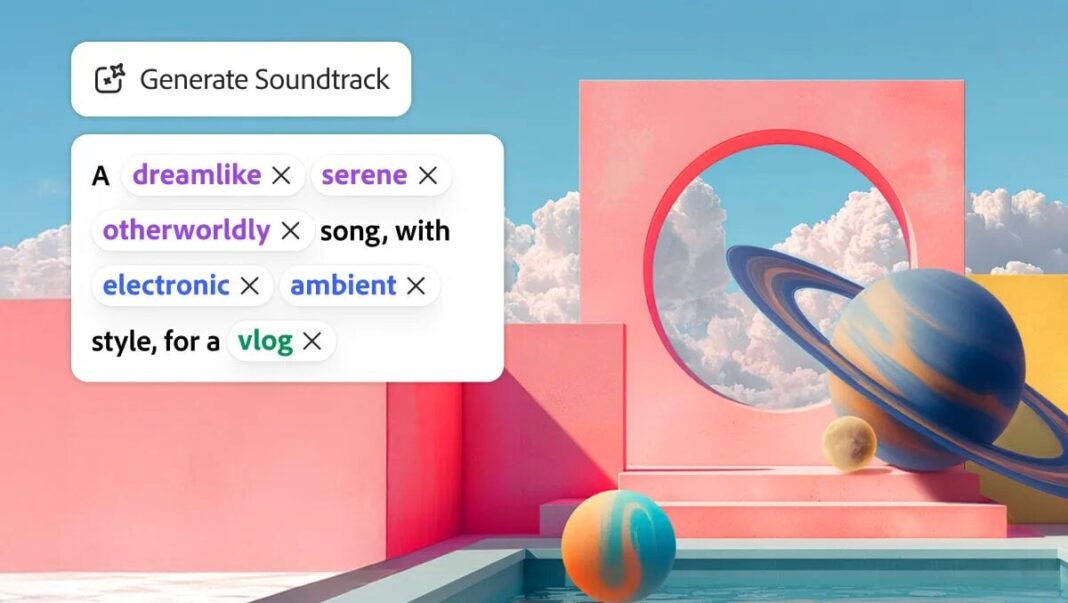It seems every tech company in the world wants to get in on the AI-generated music craze.
Just several days ago, we learned that ChatGPT and Sora maker OpenAI is planning to enter the generative AI music space, and now we have another entrant: Adobe.
The company behind Photoshop and other digital content tools has unveiled a new version of its Adobe Firefly suite of content generation tools, and among other things, this latest version can create soundtracks for videos.
Firefly’s new Generate Soundtrack tool, currently in public beta testing, can “create a custom, fully-licensed music track” for videos made in Firefly, Adobe says.
Users can input text prompts like “dreamlike” and “electronic” into the tool to guide the music’s creation, and can also tell the tool what sort of video the music will be used in. The soundtrack will be automatically trimmed to the length of the video, Adobe said in a blog post.
The tool is powered by Adobe’s Firefly Audio Model, which the company describes as being “commercially safe” and “which creates fully licensed, studio-quality instrumental tracks.”
Adobe Firefly integrates AI tech from a variety of partners, including Google, OpenAI, Luma AI, Topaz Labs, and ElevenLabs, which recently announced its own generative AI platform, trained on music licensed from music publisher Kobalt and indie music licensing org Merlin.
Adobe says its own AI tools are ethically trained on licensed content.
“We do not analyze your content to train generative AI models, unless you choose to submit content to the Adobe Stock marketplace,” the company says in a FAQ.
“Our Adobe Firefly generative AI models were trained on licensed content, like Adobe Stock, and public domain content where copyright has expired.”
“Our Adobe Firefly generative AI models were trained on licensed content, like Adobe Stock, and public domain content where copyright has expired.”
Adobe
That sets Firefly apart from some other gen-AI music tools like Suno and Udio, who made no effort to license their training content and now face multiple lawsuits from rightsholders, including all of the big three recording companies.
Firefly also includes a variety of other AI-powered tools, many of them still in public beta testing, including a video editor that can create videos up to five seconds long (though multiple videos can be edited together).
The tool has a variety of functions, including the ability to create a video from two images uploaded by the user. The video editor can “generate a unique transition from one shot to the other,” Adobe said.
The Generate Speech tool can create a voiceover narration for videos, while the image editing tool can change images based on text commands like “move the tree,” “swap the sky” or “add a cup of coffee.”
Firefly has a free-to-use version, and paid subscription versions with enhanced functionality, including a Standard plan (USD $9.99 per month), which comes with the possibility of creating 20 video clips per month, as opposed to two on the free plan. The Pro plan ($19.99 per month) comes with 40 videos per month, and the Premium plan ($199.99 per month) comes with unlimited videos.
Firefly is among a growing number of AI-powered music creation tools that are being integrated into digital media creation tools.
One example: Sweden-based Epidemic Sound recently launched Adapt, a tool that enables content creators to modify licensed tracks, such as extending songs, removing instruments or adjusting arrangements, while maintaining publishing rights and ensuring the original artists receive compensation.
Meanwhile, Chinese music streamer Tencent Music Entertainment (TME) has developed AI music tools that combine DeepSeek’s lyric generator with TME-owned QQ Music’s own AI tools, with which creators can “craft original songs that resonate with their emotions and personal experiences, further enriching their growth as creative individuals.”Music Business Worldwide





